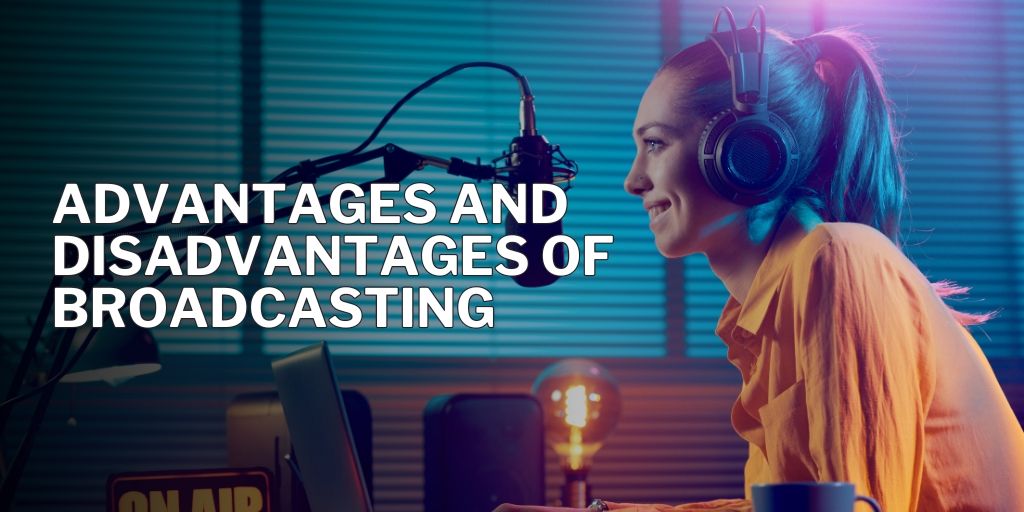Broadcasting refers to sharing audio or video content through TV or radio to a wide range of audiences. It has been around for many years and has played a significant role in the media industry. While broadcasting has many advantages, it’s not without disadvantages.
In this article, let’s discuss the advantages and disadvantages of broadcasting.
Advantages of Broadcasting
1. Wide Audience Reach
Broadcasts have the potential to reach a wide range of audiences, spanning the entire region or even the entire country. Television networks and radio signals can cover large geographic areas, allowing broadcasters to connect with people in urban and remote locations.
2. Real-Time Information
Broadcasts let you deliver messages and events in real-time, which is necessary for time-sensitive content. This real-time aspect keeps your audience up to date on the latest events.
3. Immersive Experience
Broadcasts, unlike podcasts, create an immersive experience for the audience. People tune in simultaneously to watch or listen to live events and shows, which fosters a sense of community while allowing for collective reactions and discussions, thus enhancing engagement.
4. High-Quality Content
Broadcasters often have access to professional studios, cutting-edge equipment, and experienced production teams, allowing them to produce high-quality content. They ensure that the video and audio quality is excellent, which improves the overall viewer experience.
5. Scheduled Programming
Broadcasts follow a programming schedule, with different time slots allocated for various types of content. People tune in at the scheduled times to access these programs.
The disadvantage to scheduled programming is that people can’t view these programs on-demand (i.e., at their convenience). But things are changing, and most broadcasts are now available on-demand.
6. Content Variety
Broadcasts come in different types of content, such as news, documentaries, educational programs, talk shows, and hobby-based shows. There’s something for everyone.
7. High Advertising Revenue
Broadcasters make a lot of revenue through advertisements, sponsorships, and, in some cases, subscription fees. Since television networks and media platforms already have an established audience base, you can easily find advertisers willing to pay a lot of money for the ads.
Disadvantages of Broadcasting
1. Limited Interactivity
While broadcasts offer a more immersive experience than podcasts, the audience’s ability to interact with the speaker is lesser compared to digital media — for example — social media live-streaming sessions.
Phone-ins are allowed in some types of broadcast content, like talk shows. But compared to digital media, the interactivity is lesser.
2. Geographic Limitations
Broadcasts are subject to geographic limitations. Users need to be within the transmitter range to view the broadcast, which can result in regional disparities in access and content availability. People in remote areas typically have limited access to broadcast content.
3. Lack of On-Demand Access
Unlike podcasts and streaming services, which provide on-demand access to the content, users need to view the broadcasts at the scheduled time. But this is changing rapidly, and many broadcasts are now available on demand to stay competitive.
4. Competition With Digital Media
Digital media, such as social media, podcasts, and streaming services, offer more flexibility and personalization, which has made many users shift to digital content consumption. These platforms offer more customization and on-demand access. Having said that, some broadcasters, such as Ken D Foster’s TCN (The Courage Network), are now streaming on digital media.
5. Ad Skipping
Many broadcasting platforms allow ad-skipping today, but many broadcast viewers still watch the ads, which is why companies are willing to spend a lot of money to run advertisements on broadcasting channels.
Conclusion
Broadcasting is a powerful medium for sharing audio or video content. It reaches a wide range of audiences, and it is now letting go of limitations from the past and offers more flexibility and personalization.
The choice between broadcasting and digital media depends on your goals and the preferences of your target audiences. Broadcasting will be a good choice if you have a dream of reaching a larger audience. It takes time to build an audience base on digital media platforms. But if you do so, the results will be spectacular.
Combining both broadcasts and podcasts is recommended to achieve the best results.
Ken D Foster is a best-selling author, transformational leader, business strategist, and producer of the Voices of Courage Show, syndicated in 185 countries. He is available to have a conversation with you about broadcasting on his Network TCN (The Courage Network). Set up a time with Ken.

